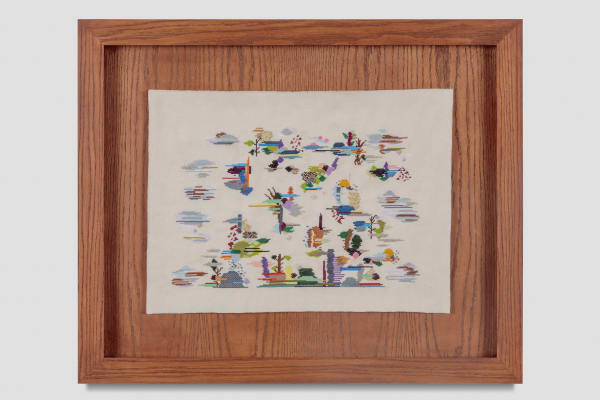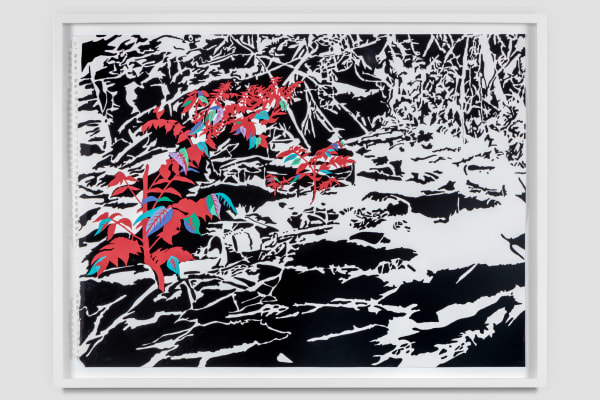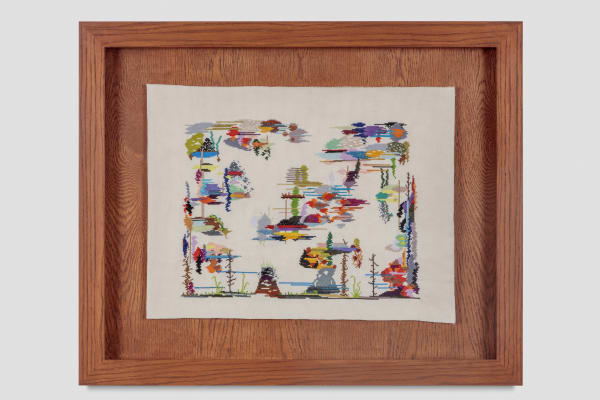Iliodora Margellos & Francesca Gabbiani
A two person show has the great advantage of presenting a substantial amount of each artist’s work, giving the opportunity for viewers to compare, to think in wider horizons and to expand their knowledge of each artist’s work.
In addition to the biographical notes of the artists—both Francesca Gabbiani and Iliodora Margellos spent formative years in Geneva—there are a number of analogies that can be deducted from their bodies of work, and their juxtaposition illuminates qualities within each.
Let’s begin with their labor-intensive approach to art, which importantly forwards the value of personal work over that of material or capital display.
Gabbiani’s cut-outs require extensive amounts of time, technical organization, a well thought-out visualization of each work, and the built-in potential to incorporate in each piece the eventual spontaneous events that determine its final creation. Gabbiani’s method is unforgiving; the piece is finalized after days, weeks and months of work. From the initial drawing (or photograph), Gabbiani constructs the image layer after layer, relying on strata of fastidiously cut archival paper, rather than the rules of perspective. The work has a hinted sculptural form, not unlike fabric appliqués, while maintaining a painterly approach. As in great paintings, Gabbiani’s works create amazing textures.
Margellos gives months to each of her embroideries, depicting scenes and abstract swatches of color. Like traditional samplers gone wild, they break the grid to tell stories that are individual and emotional, arising from a place of introspection and unbounded time. She appropriates a traditional craft, the mainstay of domestic culture of her country of residence, Greece. For centuries in the Balkan peninsula embroideries have been part of a woman’s daily life. Today, they are a favored craft in refugee camps: easy to transport, low cost of production. They are also a favored art form by Palestinian prisoners, both male and female, and they are vehicles and testimonials of solidarity, resistance and revolt. Margellos’s work also hosts amazing textures.
In shifting our attention from texture to color, we find Gabbiani and Margellos shun primary colors. Their palettes are muted, often mindful of natural tones. Not unlike Le Corbusier’s color swatches for the Swiss company Salubra, the colors the artists use orchestrate a spatial effect, rather than fulfilling a focalized pictorial and decorative function. Although often inhabiting small surfaces, they have a deep atmospheric dimension.
Neither artist values the time-cost of transaction over the work itself: pure from any obsessive interest in the advantage of speed, their focus rests on the outcomes of their labor.
Their work relies on the transcendent capacity of minutiae to give a form to the overall appearance of a piece. Each work may be fully but differently experienced from afar and in close proximity. There is an invitation to zero-in on these surfaces, to grasp all of the possibilities of each work. Every stitch and leaf counts, as if in witness to the awe the artists feel for "every living thing". Both Gabbiani and Margellos celebrate organic forms as one finds them in nature, wild growths and fine flowers.
With pain and exaltation: the devil is in the details—and God is in the details, too.
Paolo Colombo, Athens, 2018.
-
 Iliodora MargellosDoing, 2018Handmade embroidery, mixed media on metal grid sheet
Iliodora MargellosDoing, 2018Handmade embroidery, mixed media on metal grid sheet
-
 Iliodora MargellosUndoing, 2018Handmade embroidery,mixed media on metal grid sheet
Iliodora MargellosUndoing, 2018Handmade embroidery,mixed media on metal grid sheet
-
 Iliodora MargellosDoing/Undoing (1), 2018Handmade embroidery, thread on canvas
Iliodora MargellosDoing/Undoing (1), 2018Handmade embroidery, thread on canvas -
 Iliodora MargellosDoing/Undoing (2), 2018Handmade embroidery, thread on canvas
Iliodora MargellosDoing/Undoing (2), 2018Handmade embroidery, thread on canvas
-
 Iliodora MargellosDoing/Undoing (3), 2018Handmade embroidery, thread on canvas
Iliodora MargellosDoing/Undoing (3), 2018Handmade embroidery, thread on canvas -
 Iliodora MargellosDoing/Undoing (4), 2018Handmade embroidery, thread on canvas
Iliodora MargellosDoing/Undoing (4), 2018Handmade embroidery, thread on canvas
-
 Francesca GabbianiDestruction of a Radical Space IV, 2015Colored paper and gouache on panel
Francesca GabbianiDestruction of a Radical Space IV, 2015Colored paper and gouache on panel -
 Francesca GabbianiDead Nature with Bathtub, 2017Colored paper and gouache on paper
Francesca GabbianiDead Nature with Bathtub, 2017Colored paper and gouache on paper -
 Francesca GabbianiSeries Leaves (Fushia), 2016Colored paper on paper
Francesca GabbianiSeries Leaves (Fushia), 2016Colored paper on paper
-
 Francesca GabbianiSeries Leaves (Meadow), 2016Colored on paper
Francesca GabbianiSeries Leaves (Meadow), 2016Colored on paper -
 Francesca GabbianiSeries Leaves (Purple), 2016Colored on paper
Francesca GabbianiSeries Leaves (Purple), 2016Colored on paper -
 Francesca GabbianiSynedoche 1 (Destruction of a radical space), 2017Colored paper and gouache on paper
Francesca GabbianiSynedoche 1 (Destruction of a radical space), 2017Colored paper and gouache on paper -
 Francesca GabbianiSynedoche 2 (Destruction of a radical space), 2017Colored paper and gouache on paper
Francesca GabbianiSynedoche 2 (Destruction of a radical space), 2017Colored paper and gouache on paper






















